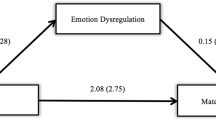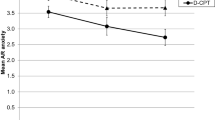Abstract
This study found that within a non-referred community pediatrics clinic sample, the severity of mothers’ trauma-related psychopathology, in particular, their interpersonal violence-related (IPV) posttraumatic stress, dissociative, and depressive symptoms predicted the degree of negativity of mothers’ attributions towards their preschool age children, themselves, and their own primary attachment figure. Results also showed that mothers with IPV-related posttraumatic stress disorder (PTSD) as compared to non-PTSD controls showed a significantly greater degree of negativity of their attributions toward their child, themselves and their primary attachment figure during childhood. The study finally found a significant reduction in the degree of negativity of mothers’ attributions only towards their child following a three-session evaluation-protocol that included a form of experimental intervention entitled the “Clinician Assisted Videofeedback Exposure Session(s)” (CAVES), for mothers with IPV-PTSD as compared to control-subjects.

Similar content being viewed by others
Notes
“Tony and Barbara” are pseudonyms for actual subjects that participated in the study after the mother Barbara had given specific consent for clinical material that was related to the dyad's participation to be presented and/or published for the benefit of health professionals and trainees.
References
Fraiberg S, Adelson E, Shapiro V (1975) Ghosts in the nursery. A psychoanalytic approach to the problems of impaired infant-mother relationships. J Am Acad Child Psychiatry 14:387–421
Schechter DS, Myers MM, Brunelli SA, Coates SW, Zeanah CH, Davies M et al (2006) Traumatized mothers can change their minds about their toddlers: understanding how a novel use of videofeedback supports positive change of maternal attributions. Infant Ment Health J 27:429–447
Lieberman AF (1999) Negative maternal attributions: effects on toddlers’ sense of self. Psychoanal Inq 19:737–756
Lieberman AF (2004) Child-parent psychotherapy: a relationship-based approach to the treatment of mental health disorders in infancy and early childhood. In: Sameroff AM, McDonough SC, Rosenblum K (eds) Treating parent–infant relationship problems: strategies for intervention. Guilford, New York, pp 97–122
Zeanah CH, Benoit D, Barton M, Regan C, Hirshberg LM, Lipsitt LP (1993) Representations of attachment in mothers and their one-year-old infants. J Am Acad Child Adolesc Psychiatry 32:278–286
Schechter DS, Coates S, Kaminer T, Coots T, Zeanah C, Davies M et al (2008) Distorted maternal mental representations and atypical behavior in a clinical sample of violence-exposed mothers and their toddlers. J Trauma Dissociation 9:123–147
Gara MA, Allen LA, Herzog EP, Woolfolk RL (2000) The abused child as parent: the structure and content of physically abused mothers’ perceptions of their babies. Child Abuse Negl 24:627–639
De Paul J, Asla N, Perez-Albeniz A, de Cadiz BT (2006) Impact of stress and mitigating information on evaluations, attributions, affect, disciplinary choices, and expectations of compliance in mothers at high and low risk for child physical abuse. J Interpers Violence 21:1018–1045
Lyons-Ruth K, Block D (1996) The disturbed caregiving system: relations among childhood trauma, maternal caregiving, and infant affect and attachment. Infant Ment Hearth J 17:257–275
Schechter DS, Willheim E, Hinojosa C, Scholfield-Kleinman K, Turner JB, McCaw J et al (2010) Subjective and objective measures of parent-child relationship dysfunction, child separation distress, and joint attention. Psychiatry 73:130–144
Schechter DS, Willheim E (2009) Disturbances of attachment and parental psychopathology in early childhood. Child Adolesc Psychiatr Clin N Am 18:665–686
Porges SW (2007) The polyvagal perspective. Biol Psychol 74:116–143
Cohen LR, Hien DA, Batchelder S (2008) The impact of cumulative maternal trauma and diagnosis on parenting behavior. Child Maltreat 13:27–38
Fonagy P, Steele M, Steele H, Moran G, Higgit A (1991) The capacity for understanding mental states: the reflective self in parent and child and its significance for security of attachment. Infant Ment Health J 12:201–217
Schechter DS, Zygmunt A, Coates SW, Davies M, Trabka K, McCaw J et al (2007) Caregiver traumatization adversely impacts young children’s mental representations on the MacArthur Story Stem Battery. Attach Hum Dev 9:187–205
Dutra L, Bureau JF, Holmes B, Lyubchik A, Lyons-Ruth K (2009) Quality of early care and childhood trauma: a prospective study of developmental pathways to dissociation. J Nerv Ment Dis 197:383–390
van den Boom DC (1994) The influence of temperament and mothering on attachment and exploration: an experimental manipulation of sensitive responsiveness among lower-class mothers with irritable infants. Child Dev 65:1457–1477
Rusconi-Serpa S, Sancho Rossignol A, McDonough SC (2009) Video feedback in parent-infant treatments. Child Adolesc Psychiatr Clin N Am 18:735–751
Blatt SJ, Zuroff DC, Hawley LL, Auerbach JS (2010) Predictors of sustained therapeutic change. Psychother Res 20:37–54
Blatt SJ, Auerbach JS (2001) Mental representation, severe psychopathology, and the therapeutic process. J Am Psychoanal Assoc 49:113–159
Zeanah CH, Benoit D (1995) Working model of the child interview (WMCI). Tulane University School of Medicine, New Orleans
Zeanah CH, Larrieu JA, Heller SS, Valliere J (2000) Infant relationship assessment. In: Zeanah CH (ed) Handbook of Infant mental health. Guilford Press, New York, pp 222–235
American Psychiatric Association (2000) Diagnostic and statistical manual of mental disorders, 4th edn. American Psychiatric Publishing, Washington
First MB, Spitzer RL, Gibbon M, Williams JB (1995) Structured clinical interview for DSM-IV Axis I disorders. American Psychiatric Press, Washington
Kubany ES, Haynes SN, Leisen MB, Owens JA, Kaplan AS, Watson SB et al (2000) Development and preliminary validation of a brief broad-spectrum measure of trauma exposure: the Traumatic Life Events Questionnaire. Psychol Assess 12:210–224
Blake DD, Weathers FW, Nagy LM, Kaloupek DG, Gusman FD, Charney DS et al (1995) The development of a clinician-administered PTSD scale. J Trauma Stress 8:75–90
Weathers FW, Ford J (1996) Psychometric properties of the PTSD Checklist (PCL-C, PCL-S, PCL-M, PCL-PR). In: Stamm BH (ed) Measurement of stress, trauma, and adaptation. Sidran Foundation & Press, Lutherville, pp 250–252
Sheehan DV, Lecrubier Y, Sheehan KH, Amorim P, Janavs J, Weiller E et al (1998) The mini-international neuropsychiatric interview (M.I.N.I.) the development and validation of a structured diagnostic psychiatric interview for DSM-IV and ICD-10. J Clin Psychiatry 59(Suppl 20):22–33; quiz 34–57
Beck AT, Steer RA, Brown GK (1996) Manual for beck depression inventory II (BDI-II). Psychology Corporation, San Antonio
Schechter DS, Brunelli SA, Myers MM (Unpublished Instrument) Maternal Attribution Rating Scale, MARS
Lorber MF, O’Leary SG, Kendziora KT (2003) Mothers’ overreactive discipline and their encoding and appraisals of toddler behavior. J Abnorm Child Psychol 31:485–494
Berlin LJ, Dodge KA, Reznick JS (2013) Examining pregnant women’s hostile attributions about infants as a predictor of offspring maltreatment. JAMA Pediatr 167:549–553
Chemtob CM, Gudino OG, Laraque D (2013) Maternal posttraumatic stress disorder and depression in pediatric primary care: association with child maltreatment and frequency of child exposure to traumatic events. JAMA Pediatr 167:1011–1018
Schechter DS, Moser DA, Wang Z, Marsh R, Hao X, Duan Y et al (2012) An fMRI study of the brain responses of traumatized mothers to viewing their toddlers during separation and play. Soc Cogn Affect Neurosci 7:969–979
Schechter DS, Rusconi-Serpa S (2011) Applying clinically-relevant developmental neuroscience towards interventions that better target intergenerational transmission of violent trauma. Signal Newsl World Assoc Infant Ment Health 19:9–16
Koenen KC, Moffitt TE, Poulton R, Martin J, Caspi A (2007) Early childhood factors associated with the development of post-traumatic stress disorder: results from a longitudinal birth cohort. Psychol Med 37:181–192
Lieberman AF, Van Horn P, Ippen CG (2005) Toward evidence-based treatment: child–parent psychotherapy with preschoolers exposed to marital violence. J Am Acad Child Adolesc Psychiatry 44:1241–1248
Acknowledgments
The authors wish to acknowledge the following sources of funding awarded to the first author, which sources made the research discussed in this paper possible: the National Center of Competence in Research (NCCR) “SYNAPSY—The Synaptic Bases of Mental Diseases” financed by the Swiss National Science Foundation (No. 51AU40_125759), the International Psychoanalytical Association’s Research Advisory Board Grant, The Bender-Fishbein Fund, the Sackler Institute for Developmental Psychobiology at Columbia University, and NIH K23 MH068405.
Conflict of interest
None.
Author information
Authors and Affiliations
Corresponding author
Rights and permissions
About this article
Cite this article
Schechter, D.S., Moser, D.A., Reliford, A. et al. Negative and Distorted Attributions Towards Child, Self, and Primary Attachment Figure Among Posttraumatically Stressed Mothers: What Changes with Clinician Assisted Videofeedback Exposure Sessions (CAVES). Child Psychiatry Hum Dev 46, 10–20 (2015). https://doi.org/10.1007/s10578-014-0447-5
Published:
Issue Date:
DOI: https://doi.org/10.1007/s10578-014-0447-5




